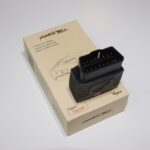Installing an OBD2 device in your car is usually a simple plug-and-play process. This guide provides a step-by-step approach to help you locate and install your OBD2 device quickly and easily. While this guide focuses on a specific type of device, the general principles apply to most OBD2 trackers.
Locating the OBD2 Port
The first step is finding your car’s OBD2 port. It’s typically located under the dashboard, often near the steering wheel column.
Common OBD2 port locations include:
- Under the steering wheel column: Look directly beneath the steering wheel, often on the lower dash panel.
- Near the driver’s side knee bolster: Check the area where your left knee rests while driving.
- Inside the center console: Some vehicles have the port inside the center console storage compartment or near the ashtray.
- Behind a panel or cover: The port might be hidden behind a removable panel or cover near the steering wheel or in the footwell.
If you can’t find the OBD2 port using these guidelines, consult your vehicle owner’s manual. It will provide a precise location specific to your car model.
Installing the OBD2 Device
Once you’ve located the OBD2 port, installing the device is straightforward:
-
Ensure Compatibility: Before starting, confirm that the OBD2 device is compatible with your vehicle’s make and model.
-
Turn Off the Engine: Switch off the ignition and ensure the car is parked in a safe location with good GPS coverage. A clear view of the sky will help the device acquire a GPS signal more quickly.
-
Plug in the Device: Insert the OBD2 device connector into the port. It should fit snugly and securely. You’ll hear a click when it’s properly connected.
-
Start the Engine: Turn the ignition on and start the engine. Let the vehicle idle for several minutes to allow the OBD2 device to establish a connection and acquire a GPS signal.
-
Verify Connection: The OBD2 device usually has an indicator light to confirm power and connection. Refer to the device’s manual for specific instructions on verifying its operation. Depending on the device, you may need to download a corresponding app to track and monitor data.
Troubleshooting
If the device doesn’t seem to be working:
- Check the Connection: Ensure the device is firmly plugged into the OBD2 port.
- Consult the Manual: Refer to the device’s user manual for troubleshooting tips.
- Contact Support: If you’re still experiencing issues, reach out to the device manufacturer’s customer support for assistance. They can provide specific guidance based on your device and vehicle.
By following these steps, you can successfully install your OBD2 device and start utilizing its features. Remember to always refer to the manufacturer’s instructions for your specific device model.

